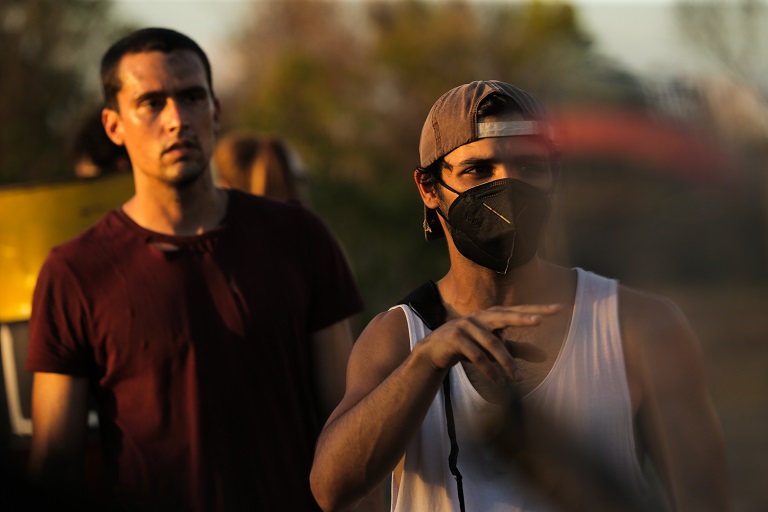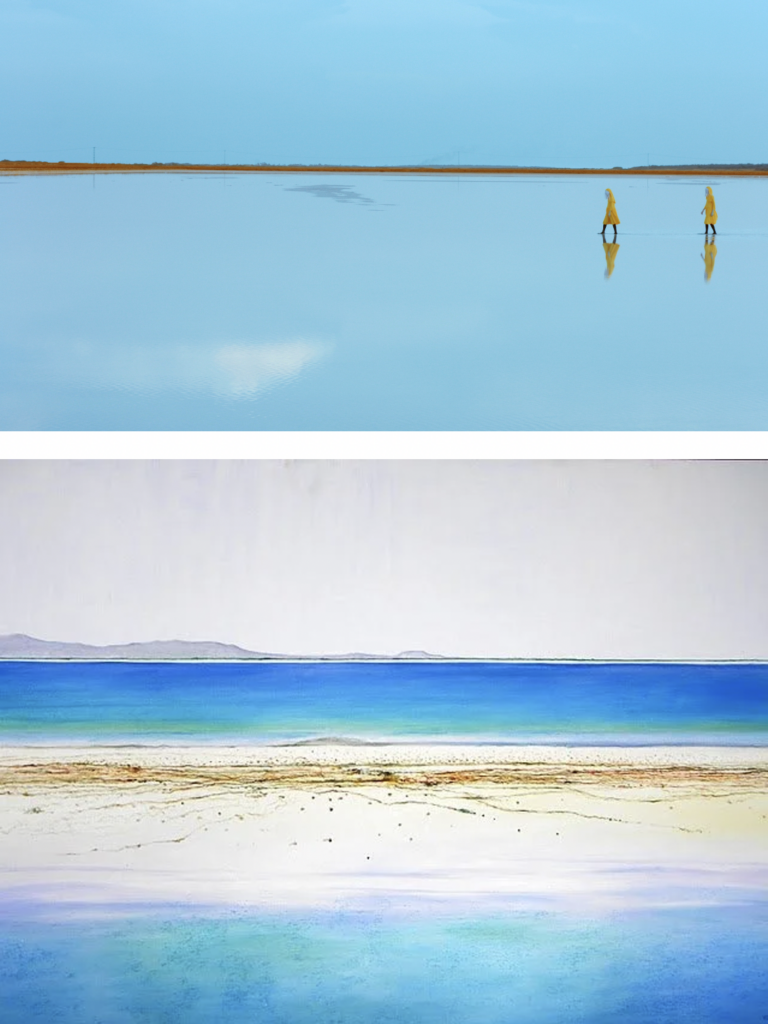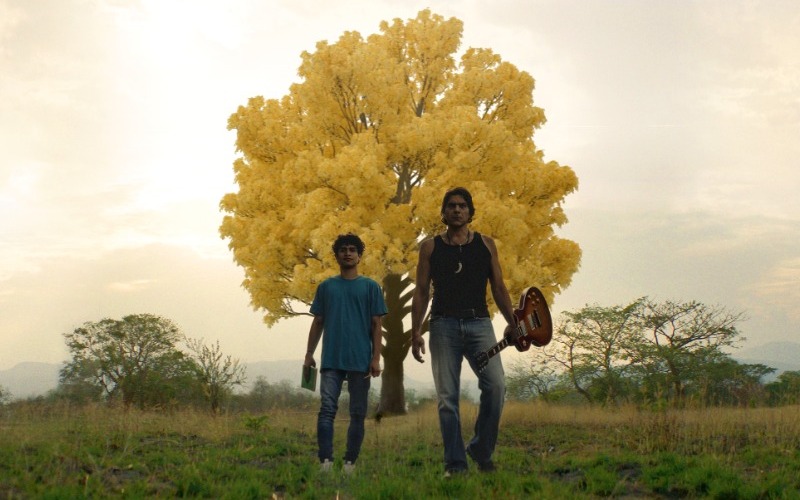Venezuelan Movies, While Facing National Ghosts, Are Entering New Frontiers
After a long crisis, Venezuelan cinema is reconnecting with local audiences –and succeeding abroad– while exploring new dimensions and facing sensitive national topics


After a long economic crisis and a pandemic that forced Venezuelan cinemas to close, audiences returned to movie theaters to encounter not only the usual American big blockbusters but also movies made by our own people. But, while these films were celebrated, they didn’t represent the escapism and playful entertainment that going to the movies usually means. This year, two films dared to remind local audiences of their wounds and their ways of dealing with painful situations, such as migration, grief and reinvention. These films share adepts, and topics like catharsis and forgiveness.
Simón, the most recent Venezuelan blockbuster, represents a new way of dealing with trauma. Some sort of “collective therapy”, says its director Diego Vicentini. The film tells the story of Simón, a Venezuelan young protest leader who escapes the clutches of the Venezuelan regime and arrives in Miami – where he battles trauma and guilt while trying to achieve political asylum.
Vicentini himself left Venezuela with his family in 2009, at age 15, due to the country’s crime crisis. After studying Philosophy at Boston College, Vicentini decided to follow the typical advice given to young filmmakers and make a film about something they know and care about. That was the 26-minute short film Simón, originally his master’s thesis in cinema at the Los Angeles Film Academy.
“During the 2017 Venezuelan protests, I felt guilty for not being in the country to participate in that fight with my generation”, Vicentini says, “Cinema became a way to contribute to that fight, either by doing something that matters to me and also by letting foreigners know the country’s situation.”
The intention was to address a universal story where everyone could connect with the characters’ emotions, despite the psychological wound still fresh for the Venezuelan audiences. “I said to myself, ‘maybe people won’t want to go see it, it is an overwhelming subject’. However, the impact has been very positive”, the filmmaker says, “Just as it happens with Simón in the film and his asylum process as forced therapy, the same thing happens when you go to see the film. It is a collective therapy: spending almost two hours in the same space, with other Venezuelans and facing certain memories and feelings. But even so, the film takes you by the hand to a lighter space of forgiveness, of allowing you to forgive yourself… I think it is something that we also need as Venezuelans.”

A recollection of memories, painful images and dialogues that sounds very much like the country Venezuela still is, Simón‘s screenplay was asked by the Academy of Motion Picture Arts and Sciences to be added to its permanent library collection. The film also brought Venezuela back into the race for the Goya Awards, almost ten years after the country was recognized in the Best Ibero-American Film category for the film Azul y No Tan Rosa (2012, directed by Miguel Ferrari). As Vicentini explains, “It goes beyond being an artistic recognition of your film. Both the Goya and the Oscars represent a window and a vehicle to continue making our history as Venezuela visible, and make this kind of international complaint.”
2017 was the year when Nico Manzano, a Venezuelan filmmaker educated in Spain, decided to venture into a solo project and make a film about a young musician dealing with Venezuela’s multidimensional crisis. That’s how Yo y Las Bestias, a surreal film with a poster referencing Caracas’ María Lionza sculpture, came to be.
Still in the editing room, Manzano’s debut feature started to make some noise outside the country: it competed at the 2020 regional Ventana Sur film festival, where it won three awards. In 2021, the film premiered at two class A film festivals: the Mar de Plata Festival in Argentina and at the Tallinn Black Nights Film Festival in Estonia. Its tour continued in 2022 with international screenings, winning five statuettes at the Venezuelan Film Festival in Mérida until its premiere in Venezuela during the spring of 2023.
Manzano is specialized in music videos, live visuals and commercials, and the film condenses several of his obsessions: the sound, the music and altering the codes of reality in fiction. “Yo y las Bestias has many of my concerns resolved. Sometimes you don’t identify what you’re talking about until you finish writing or even editing. I am at the crossroads of my second work right now. I try not to let this paralyze me, but after a relatively successful first work, continuity with variations and maturity is expected”, said the director via email.
The film was made in Venezuela during the 2017 protests, a period of national uncertainty, and was released worldwide during the COVID-19 pandemic, a period of global uncertainty. “To be honest, I don’t think we’ve fully digested the two events yet. Also, if you add migration to this, I understand why there are so many emotionally exhausted people today”, Manzano says. Nevertheless, it was a film made with honesty, according to the director, “but also with respect for the public. It was done with the intention that the public complete it as an experience through the details without resulting in explanations. I like that it worked”.
Both films connected with the audience in different ways and outcomes, says Humberto Sánchez Amaya, a cultural journalist. For him, Yo y Las Bestias represents a new way of telling the country. “We have the point of view of a musician who sees his world falling apart and yet he maintains his values. The lonely path of the film’s lead character is actually the same taken by those of us who have stayed in the country”, Sánchez Amaya says. Likewise, there is an aesthetic factor that attracts a lot of attention, because it breaks with certain patterns in Venezuelan cinema. Manzano’s main references are 20th century Venezuelan visual artists, the director says himself, like Ramón Vásquez Brito and Jesús Soto.

In the case of Simón, Sánchez Amaya says, “it is the first film that directly addresses a topic that, in certain ways, Venezuelan artists had covered up with certain exceptions: this is the case of the 2017 protests and their consequences. People now begin to see each other there, both those who stayed and those who left. What is praiseworthy about Simon? That it is the first film that does it and has that impact of a cinematic phenomenon specially on box office success and connection with an audience that still has a lot to reflect on its sensitive topics such as riots and immigration.”
Regarding Yo y las Bestias, the journalist doesn’t consider it a box office feat. “However, it was a phenomenon for a niche follower of Venezuelan cinema, the most independent, who found an approach to a topic in a quite genuine, original and different way from what people are used to in our cinema.”
About the support that Venezuelan cinema has received from the public and private sectors, Humberto Sánchez Amaya recalls that this support intrinsically depends on factors such as public attendance at the cinema, which has diminished as a result of living in a nation with economic precariousness.
The cultural journalist explains, in general terms, what is established in the National Cinematography Law on how the financing of the film sector works in the country: “There is a lot of intervention from the public sector, understanding that the National Autonomous Center of Cinematography (CNAC), the entity in charge of the development, promotion, dissemination and protection of national cinematography, is an organization that belongs, in operation, to the State, but whose financing is diverse.”
He adds that this financing comes from the Film Promotion and Financing Fund (FONPROCINE), which by Venezuelan law is funded by a percentage of what is collected at the box office, from cable companies and other related companies.
“In recent years, this has reduced its capacity due to the same situation. Logically, if there are fewer tickets sold in a year, there is less percentage of income in FONPROCINE. But let’s say that in the last two years there has been an attempt to recover it, to resume certain forms of financing, especially for post-production or other projects, which seem to be on the right track for better functioning in terms of the CNAC.”, Sánchez Amaya says, “The support of the private sector for cinema has also decreased, due to the sociopolitical situation of the country, it has little room for realization. However, there were times when private companies could finance a film.”
He assures that both Simón and Yo y las Bestias were developed with each crew’s own resources, with Vicentini’s film attracting foreign investors, and with Manzano’s feature being paid for by the director himself.
The cultural journalist is cautious about what happened this year with Venezuelan cinema. The local box office added new numbers, but they are far from better than previous years, with films such as Papita, Maní, Tostón (2013) and La Casa del Fin de los Tiempos (2013). While it’s a good year for Venezuelan cinema following a decade-long economic depression, a pandemic and mass migration, films like Simón –the highest-grossing Venezuelan film of the year– “barely reached 100,000 viewers”, Humberto Sánchez Amaya points, “There is a gradual improvement, but it is because we come from an almost desertic scenario. There is still a lot to build.” To put it in perspective: “Barbie”, only on its opening weekend, attracted over 210,000 viewers.

But Venezuelan cinema in 2023 went beyond showing a wounded society through rude and not very hopeful ways. Shot almost in its entirely in Acarigua, the main city of the Western plains in Venezuela, La Sombra del Sol –directed by Miguel Angel Ferrer– shows the story of Alex, a young deaf man who asks his estranged older brother to join him in a musical contest to opt for a cash prize and the fulfillment of a dream.
“There is a very important film that was not a box office success either, but that does not mean that it is a great film”, highlights Sánchez Amaya, as a film that “will remain for posterity as one of the great feature films of recent Venezuelan cinema.”
Sánchez Amaya continues: “Not only is it a film with a very good production, Hollywood-style, but it is one of the films that best understands the adversity and setbacks of a country like Venezuela; it also understands very well how the inhabitants have known how to overcome and overcome their way what is happening. For me, La Sombra del Sol is a film that cannot fail to be mentioned when talking about Venezuelan cinema in recent years”.
Currently, all three filmmakers –Vicentini, Manzano and Ferrer– live outside Venezuela, like many of their colleagues. But, for Sánchez Amaya, migration could continue generating phenomena like Simón and Yo y Las Bestias due to Venezuelan filmmakers experimenting with other contexts, muses and influences. “Simón” is expected to join Netflix’s catalog in March.
“That is the cinema that is going to happen right now”, he says, “And that is going to be another discussion that will take place in these times: in this context, what is the new Venezuelan cinema? Is it a cinema made by Venezuelans, but with crews and actors of other nationalities? It is undeniable that other dynamics are going to form and they will force us to discuss what a Venezuelan film is.”
Caracas Chronicles is 100% reader-supported.
We’ve been able to hang on for 22 years in one of the craziest media landscapes in the world. We’ve seen different media outlets in Venezuela (and abroad) closing shop, something we’re looking to avoid at all costs. Your collaboration goes a long way in helping us weather the storm.
Donate




